What is TreaTech?
TreaTech is a Swiss-based private company shaking up the waste treatment industry with its groundbreaking technology. Founded in 2015 by Life Sciences and Chemical Engineers from the Swiss Federal Institute of Technology in Lausanne, the company’s mission is clear: harness the power of the circular economy to turn waste into valuable by-products. At the heart of their innovation lies a patented process called catalytic hydrothermal gasification (HTG). This tech converts a wide range of waste streams—often destined for incineration—into reusable resources in a way that’s both sustainable and cost-efficient. Think renewable gas, clean water, and essential minerals like phosphorus, nitrogen, and potassium. It’s a modular solution that fits right into existing on-site processes, transforming waste into something truly valuable.
Main Benefits of TreaTech’s Technology
What makes TreaTech stand out? Here are some key facts and figures that highlight its impact:
- Converts 99% of organic carbon in waste into pollutant-free, methane-rich renewable gas.
- Eliminates off-site transportation of waste, drastically reducing carbon footprint.
- Produces clean water that can be reused on-site or off-site, supporting a closed-loop system.
- Recovers minerals like phosphorus, nitrogen, and potassium, which can be turned into fertilizers.
- Modular design allows seamless integration with existing industrial processes.
- Renewable gas output can be injected into the grid, stored, or used to power on-site operations.
- Supports both short-term energy resilience and long-term climate impact reduction.
How Catalytic Hydrothermal Gasification Works
So, what’s the magic behind TreaTech’s process? Catalytic hydrothermal gasification (HTG) uses water at high temperatures and pressures, combined with catalysts, to break down organic waste. Instead of burning waste and releasing harmful emissions, HTG transforms it into methane-rich gas, clean water, and minerals. This approach not only captures the full value of waste but also avoids the pollutants typically associated with incineration. Plus, the methane-rich gas produced can power the process itself, creating a neat circular system that’s energy-efficient and environmentally friendly.
Applications Across Industries
TreaTech’s technology isn’t limited to one type of waste or sector. It’s designed to handle a broad range of waste streams from various industries and municipalities. Whether it’s industrial by-products, municipal solid waste, or other organic materials, the system adapts to treat these efficiently. This flexibility means businesses can reduce their environmental impact while recovering valuable resources that would otherwise be lost. It’s a win-win for companies looking to boost sustainability and for communities aiming to manage waste more responsibly.
Supporting the Circular Economy
At its core, TreaTech champions the circular economy. Instead of viewing waste as a problem, it sees it as an opportunity. By recovering minerals that can be turned into fertilizers and producing clean water for reuse, the technology closes the loop on waste treatment. This means less reliance on virgin resources and fewer pollutants released into the environment. The renewable gas produced replaces fossil fuels, helping to mitigate climate change. It’s a holistic approach that benefits businesses, communities, and the planet alike.
Project Impact on Sustainable Development Goals (SDGs)
- SDG 6: Clean Water and Sanitation – through production and reuse of clean water.
- SDG 7: Affordable and Clean Energy – by generating renewable methane-rich gas.
- SDG 9: Industry, Innovation, and Infrastructure – via innovative waste treatment technology.
- SDG 11: Sustainable Cities and Communities – by improving waste management practices.
- SDG 12: Responsible Consumption and Production – supporting circular economy principles.
- SDG 13: Climate Action – reducing greenhouse gas emissions and fossil fuel dependency.
Looking Ahead: The Future of Waste Treatment
TreaTech’s approach offers a glimpse into the future of sustainable waste management. As industries and municipalities face increasing pressure to reduce their environmental footprint, solutions like catalytic hydrothermal gasification provide a practical and scalable answer. By turning waste into valuable resources on-site, companies can cut costs, reduce emissions, and contribute to a more resilient energy system. It’s not just about managing waste—it’s about rethinking it entirely, making waste treatment a key player in the fight against climate change and resource depletion. The journey toward a cleaner, greener future just got a whole lot more exciting.





















